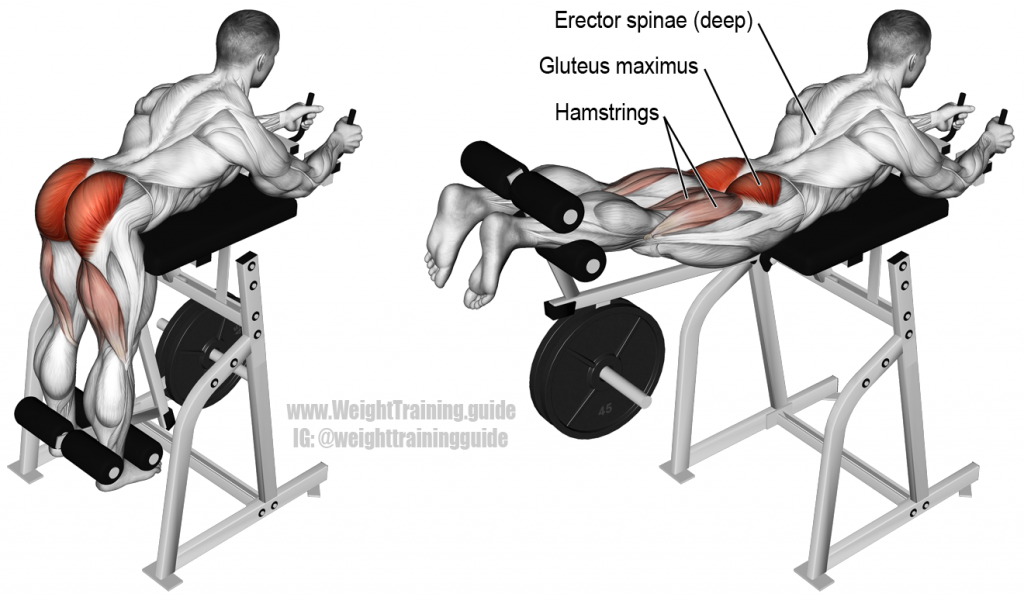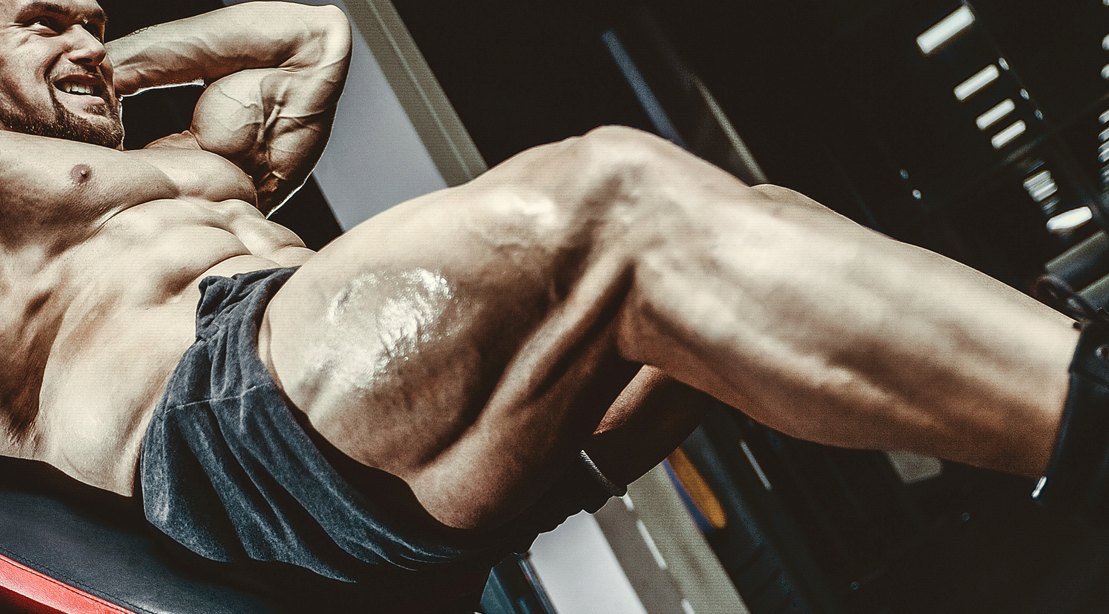The posterior chain is responsible for a lot. If you want elite strength, athleticism, posture, looks, love-making abilities, and more, you need to train your posterior chain.
When people think about their posterior chain, they think about their hamstrings, glutes, and spinal erectors.
In actuality, your posterior chain extends from your heels to your neck.
But for the sake of this particular article, we will primarily focus on exercises that hammer your hamstrings, glutes, and erectors.
The posterior chain is the muscle group responsible for the “Hinge” pattern movement.
The Hinge pattern movement is the driving force behind the Deadlift and many common day-to-day tasks.
An underdeveloped posterior chain — often caused by a sedentary lifestyle — is responsible for millions of back problems around the world.
But first, before learning how to run, we will learn how to crawl.
Let’s get the list started, shall we.
1. Best Posterior Chain Exercises: The Kettlebell Swing
I have decided to include the Kettlebell Swing into this list as number one because it should be your starting point before learning how to deadlift.
Learning how to Hinge properly should be your priority, ingraining correct motor patterns, before deadlifting.
Many untrained gym goers suffer from some form of gluteal amnesia — in other words, they don’t know how to activate their behind.
I was one of them in my early days.
To deadlift effectively and safely, you have to learn how to hinge and the Kettlebell Swing is the best way to become acquainted with this movement.
2. Barbell Hip Thrust
This is hands down, pound for pound, one of the most brutally effective exercises to improve athleticism, your love-making ability, and develop your posterior chain.
You often see blossoming Instagram models perform this exercise — commonly seen on the Smith Machine — but there is absolutely no shame in doing this exercise if you don’t look the part.
As I mentioned in the section about Kettlebell Swings, it is best to learn how to Hinge properly.
In concert with the Kettlebell Swing, the Barbell Hip Thrust will add mass to your ass and help grow your posterior chain.
If there were one exercise I’d prescribe to couch potatoes with lower back pain, it would be the Barbell Hip Thrust.
Lifters of all stripes should be using this to develop their posterior chain if it is a lagging body part.
3. Reverse Hyperextension
You should be doing Reverse Hypers if you want to take your lifting to the next level. Become more athletic, blow up your Squat and Deadlift, add mass to your ass, decompress your spine, aid with recovery — all of these wonderful things, and more, will happen if you start programming Reverse Hypers into your workouts.
No matter whether you’re a bodybuilder, powerlifter, strength athlete, athlete of any trade, or just a casual lifter, you can all benefit from doing the Reverse Hyper (Reverse Hyperextension).
What Does the Reverse Hyper Target?

The Reverse Hyper targets the entire posterior chain: glutes and hamstrings, directly; spinal erectors and calves, indirectly.
The strength curve of this exercise is exaggerated near peak contraction, meaning that the further along the movement you get, the harder it becomes.
Traditionally reserved as a workout finisher, the Reverse Hyper is best used for slightly hyper rep ranges — anywhere between 8-20 reps as the goal isn’t to lift as much weight as possible, but to get decent reps at a steady tempo.
The only problem with this exercise is that many gyms don’t have the right equipment, so you may need to use your imagination when it comes to setting up the exercise.
Far too few lifters take spinal decompression seriously, but repeated spinal loading without decompression work or mobility work at a minimum can cut your lifting career short.
Imagine training week in, week out, loading up several plates a side for your Deadlifts, Squats, Barbell Rows, and Overhead Presses without doing any work to counteract that downward pressure… it could be a recipe for disaster.
And I know some people might skip over doing these exercises because they’re boring or they feel like a waste of time.
Now, there’s no excuse to avoid decompression work as you will feel like you are doing something.
As we mentioned in our article on Spinal Decompression:
Another very effective spinal decompression exercise is the reverse hyper. You’ll need a reverse hyper machine to perform it, however.
Louie Simmons, the famous father of Westside Barbell, fractured one of his lumbar vertebrae as a young man and was told he would never lift again. Of course Louie being Louie, he had other ideas, and through a programme of rehabilitation that included using reverse hypers, he was able to get back to lifting absurd poundages – something he continues to do to this day.
4. Nordic Glute-Ham Raise
This is another brutal bodyweight leg exercise, but it’s often programmed into many athlete’s training regimens as it quickly strengthens the hammies like no other. It is often incorporated in the programs of athletes who have suffered from hamstring problems to prevent future injury.
A lot of athletes overtrain their quads by prioritizing the squat.
And what happens?
Well, they pull/tear their hammies because their quads are mechanically stronger than their hammies.
And this exercise can help to rapidly address those strength imbalances.
Get a training partner, friend, lover, whoever, to hold down your heels while you slowly descend as far as you can toward the floor, then press up and curl your hammies as hard as you can.
If you can make it 45 degrees to the floor without falling over completely, you’re doing remarkably well. Just make sure that you have your arms extended to break your fall.
The only people I have seen successfully complete this movement all the way to the floor without breaking their fall are petite 100lb soaking wet weightlifters.
It is incredibly challenging.
Aim for 6-10 reps per set and try to get lower than last time before falling. Try to make the negative portion (the descent) last around 3-5 seconds before falling.
Banded Romanian Deadlifts
Romanian Deadlifts are arguably one of the most commonly used posterior chain exercises out there.
Adding resistance bands to the mix, however, make this the Romanian Deadlift terrifying variation one that will shock your posterior chain.
This little addition — preferably attached to the barbell — will increase tension throughout the movement, forcing your hamstrings and glutes to work harder towards lockout.
Ideally, you should be using a 3-second eccentric and 1-second concentric tempo, paying special attention to avoid rounding your lower back.
The first few times you perform this exercise will be sore in the days after training, but the benefits to be reaped will be enormous.
When I was a powerlifter, I used to employ this posterior chain developer to great effect, specifically targeting my weaknesses in the Deadlift.
You can also use this exercise to avoid back pain in the future, sprint faster, and add slabs of muscle onto your rear end to improve your all-round look.

Don’t hesitate to email us at [email protected] for personalized coaching and a client questionnaire if you’d like DEDICATED tailor-made personal training on strength training, building muscle, losing fat, developing athleticism, and more — all to your liking, lifestyle, habits, and taste!
Otherwise, don’t forget to claim your FREE eBook detailing how to lose 20lb of fat while building muscle in 12 weeks! You can claim it here.
Alternatively, you can pick up a FREE eBook on fundamental strength principles offering an introductory workout program.











